Just for you, because it is a special day….

Of course, the truth is never quite as sugary as the intoxicatingly sweet dish served up by our modern media moguls. While we’re invidiously indoctrinated to think of Valentines Day as a sweet and dreamy lovey-dovey Hallmark moment of sycophantic night-time murmurings, best trotted out (a minimum of) once a year, in truth VALENTINE “was a holy priest in Rome, who, with St Marius and his family, assisted the martyrs in the persecution under Claudius II. He was apprehended, and sent by emperor to the prefect of Rome, who, on finding all his promises to make him renounce his faith ineffectual, commanded him be beaten with clubs, and afterward to be beheaded, which was executed on the 14th of February, about the year 270.”
So, sent to the prefect! Then beaten to death and thence beheaded – sounds much like the storyline for many a modern schoolyard romance. He’s the patron saint of epilepsy too, which sounds like he got the short end of the stick in terms of luck. Yet still we venerate him, or celebrate his holy day, in a Bachanalian orgy of disorder, hoping for a right royal bonking by the bedpost later on. And you expect red roses for that?
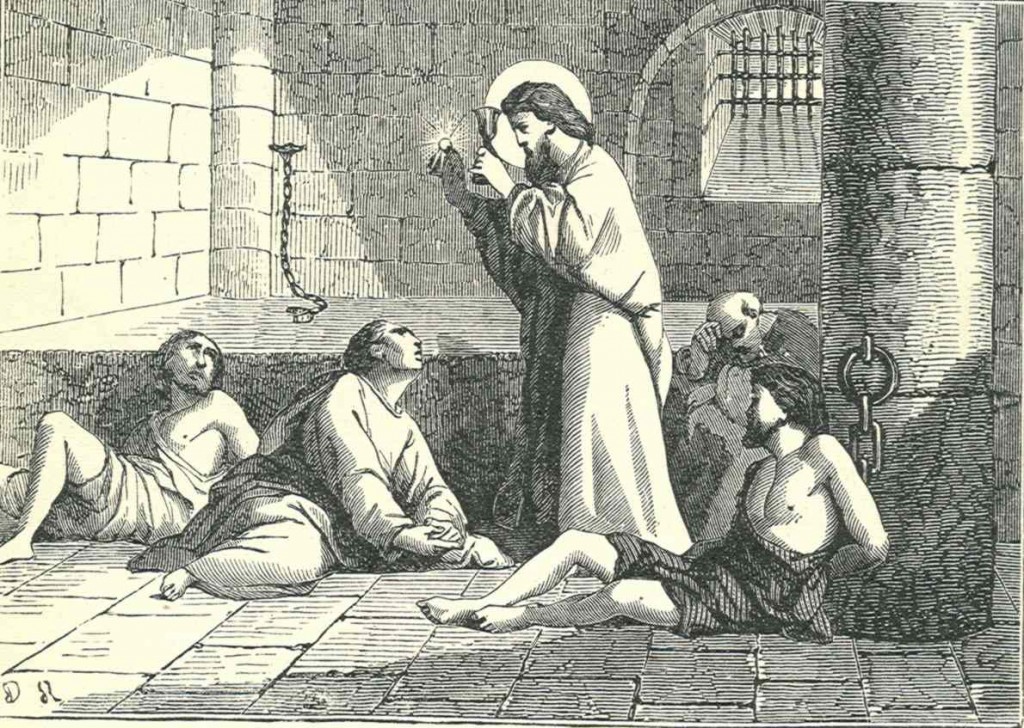
Above: as he was then, and below: as he is now, apparently, his “relics” in a crystal box.

The truth, as always, is more interesting than the fiction put out by the corporate card companies. Valentine is not quite the cupid we are driven to believe. Looking at where St Valentine is now buried, we find that “Pope Julius is said to have built a church near Ponte Mole to his memory, which for a long time gave name to the gate, now called Porta del Popolo, formerly Porta Valentini.”
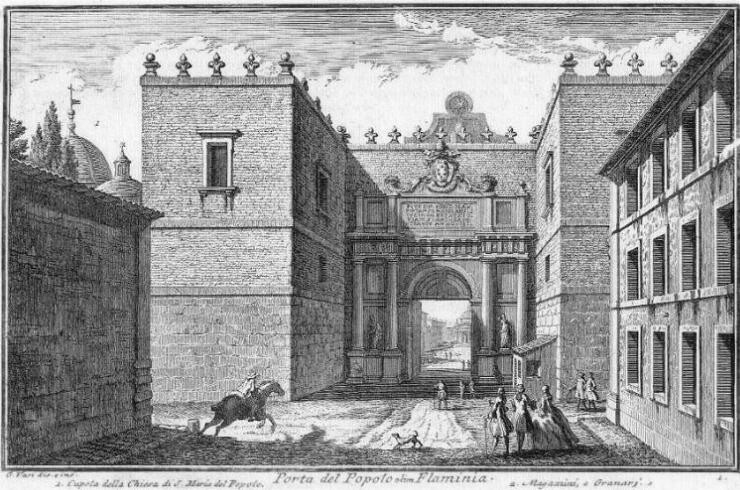
(Giuseppe Vasi, Le Porte e le Mura di Roma – 1747)
The gate is standing, still, in Rome, and used in an everyday manner the way those Romans do. So what happened to his body? Well:
“The greatest part of his relics reside now in the church of St. Praxedes. To abolish the heathen’s lewd superstitious custom of boys drawing the names of girls, in honor of their goddess Februata Juno, on the 15th of this month, several zealous pastors substituted the names of Saints in billets given on this day.” And what a great church that is – simply gorgeous piece of over the top gilded byzantine celebration, with St Valentine residing in his tiny coffin somewhere in the crypt of St Praxedis, who had a habit of looking after murdered Christians:

I’ll bet that by now, if you’re still reading, you’ll be asking just who St Praxedis was – certainly not as well-known as St Valentine. Well, the story goes that St Praxedis was: “a 2nd-century daughter of a disciple of St Paul living in Rome, and sister of St. Pudentiana. When the Emperor Marcus Antoninus was hunting down Christians, St. Praxedis sought them out to relieve them with money, care and comfort. Some she hid in her house, others she encouraged to keep firm in the faith. She likewise cared for the severed bodies of those martyred for their faith. St. Praxedis was at first venerated as a martyr in connection with the Ecclesia Pudentiana, but afterwards a separate church was built in her honor, on the alleged site of her house, to which, when it was rebuilt by Pope St. Paschal I (the present Santa Prassede), her relics were taken.” And so here she is, in a painting by Vermeer, mopping up the blood of dead and dying Christians who were, apparently, beheaded in front of her:

Nothing to do with urbanism in Wellington of course, but the urban link comes in with the more modern massacre by Al Capone, which we have all heard of – the Valentines Day Massacre, where numerous bodies were found in 1929, machine gunned to death in a warehouse in Chicago.
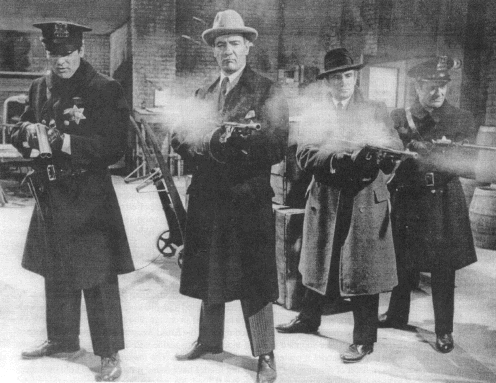
Things as they were then, it caused quite a stir back in the day, as the crowd gathered round and gazed in horror…

……
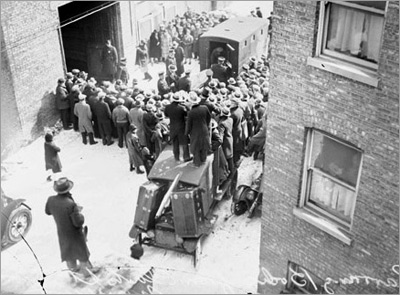
Newspapers ran VERY LARGE HEADLINES – the sort of thing we reserve nowadays for Harvey Norman 48-month No Interest deals on new whiteware (show your spouse how great your love is – buy a vacuum cleaner!), but back then it meant that something really BIG had happened:
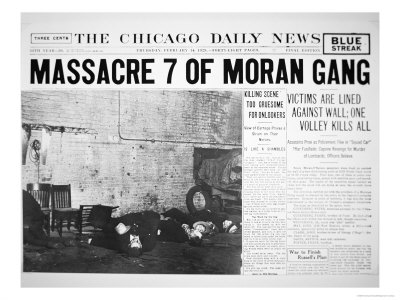
Which reminds me, in a roundabout way, of our recently departed dictator Mubarak, and his solution to a previous problem with islamic fundamentalist terrorists. These fundamentalists brutally massacred 62 people (including 58 foreign tourists) in 1997 at an Egypt must-see tourist spot, the temple of Queen Hatshetsup. The terrorists then allegedly all killed themselves.

Knowing what such bad publicity would do for tourism, the country’s only real source of income, Mubarak took some extreme measures. Although up to then Mubarak had been very careful not to be too harsh on the Muslim hardliners, the murdering of tourists en masse was clearly a step too far. Never a man for dithering around with talking when action would do instead, Mubarak’s regime rounded up a fair bunch of Muslim extremists (over 50 of them, from memory) and after a short show trial, had them all machine-gunned to death in a show of strength. Tourism recovered quite well after that.
Which shows just how tight a grip he had over the country for the last 30 years. With Mubarak gone, who knows what will happen in Egypt. Certainly not instant democracy and happiness and light – more likely to be a nasty islamic uprising and implementation of sharia law, rather than anything democratic.

In any case, its off my holiday vacation list for the next week while – and the lack of tourism all round is bound to have a bad effect on the Egyptians, and then who knows what they will be walking like. As a comparison, our possible non-hobbit filming caused doom and gloom in the whole country – imagine what our country would be like if all the tourists decided to stop coming here? Well, probably a fair few less camper-van accidents, that’s for sure, but otherwise, we’d be a sad and lonely little place.
So, after that whirlwind tour through history, it’s back to reality, and a charming farewell greeting card from me:


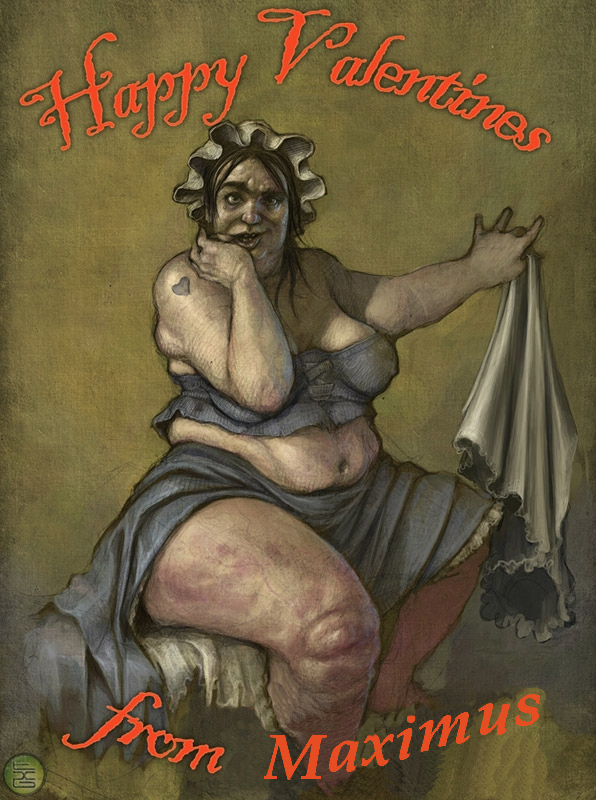



Max – You’re prettier than I thought..
I’ll bet you a tenner there’ll be no sharia law in Egypt (for the immediate future at least, say 5 years) – it’s way too secular.
And I could definitely cope with an NZ without tourists.
As an aside, seeing as you seem short on subject matter, how about some blog postings on interesting local houses/ buildings?
“Interesting local houses/buildings?”
You mean, all those hours of work put into this post, researching St Praxedis and St Pudentia and St Valentine, and you think I should just get back to what I’m meant to be doing?
Some interesting snippets, on:
the Late Latin word pudentia
derived from the Latin word pudere (to be ashamed; be ashamed; make ashamed; [me pudet => I am ashamed]; it shames, make ashamed; [me tui pudet => I am ashamed of you])
and
“The popular customs associated with Saint Valentine’s Day undoubtedly had their origin in a conventional belief generally received in England and France during the Middle Ages, that on 14 February, i.e. half way through the second month of the year, the birds began to pair. Thus in Chaucer’s Parliament of Foules we read:
For this was sent on Seynt Valentyne’s day
Whan every foul cometh ther to choose his mate.
For this reason the day was looked upon as specially consecrated to lovers and as a proper occasion for writing love letters and sending lovers’ tokens. Both the French and English literatures of the fourteenth and fifteenth centuries contain allusions to the practice. …The custom of choosing and sending valentines has of late years fallen into comparative desuetude.”
http://www.newadvent.org/cathen/15254a.htm
Here’s something Valentish for you:
“In what is described as the perfect Valentine’s Day gift, New York’s Bronx Zoo is offering the chance to name a Madagascar hissing cockroach after that special someone in your life.
“Flowers wilt. Chocolates melt. Roaches are forever,” the zoo said on its website about the name a roach gift, which was also billed as a limited Valentine’s Day offer.
More than 1,000 people chose the cockroach option for their Valentine in the first 24 hours of the offer this week, a zoo spokesman said.”
Nice!
http://www.stuff.co.nz/oddstuff/4651887/The-roach-to-romance
A different take on the origins…
“From Feb. 13 to 15, the Romans celebrated the feast of Lupercalia. The men sacrificed a goat and a dog, then whipped women with the hides of the animals they had just slain.
The Roman romantics “were drunk. They were naked,” says Noel Lenski, a historian at the University of Colorado at Boulder. Young women would actually line up for the men to hit them, Lenski says. They believed this would make them fertile.
The brutal fete included a matchmaking lottery, in which young men drew the names of women from a jar. The couple would then be, um, coupled up for the duration of the festival – or longer, if the match was right.
The ancient Romans may also be responsible for the name of our modern day of love. Emperor Claudius II executed two men — both named Valentine — on Feb. 14 of different years in the 3rd century A.D. Their martyrdom was honored by the Catholic Church with the celebration of St. Valentine’s Day.
Later, Pope Gelasius I muddled things in the 5th century by combining St. Valentine’s Day with Lupercalia to expel the pagan rituals. But the festival was more of a theatrical interpretation of what it had once been. Lenski adds, “It was a little more of a drunken revel, but the Christians put clothes back on it. That didn’t stop it from being a day of fertility and love.”
Around the same time, the Normans celebrated Galatin’s Day. Galatin meant “lover of women.” That was likely confused with St. Valentine’s Day at some point, in part because they sound alike.
from
http://www.npr.org/2011/02/14/133693152/the-dark-origins-of-valentines-day
>They were naked
Anyone who has watched Spartacus (the TV series, not the old film) will know that Romans were naked pretty much all the time. In fact it is a wonder they bothered owning clothes.
I once wore a sheet as part of a re-enactment of the death of Caesar on the actual spot he was killed on the ides of March. The locals were a little bewildered since our version involved elements of Shakespeare and beer.
Am most impressed at your dedication to faithful recreations of historic moments, Mr David P. You deserved that beer, I am sure.
Not actually sure that the Romans did “own clothes”. From what I gather with my exhaustive knowledge of Roman history, gleaned entirely from old Carry-on films and late-night re-runs of I Claudius, all they seemed to own were white sheets, old sandals, and an awesome array of daggers.
oooh, and one more thing: “the ides of March”
Always thought that was a Time, rather than a place. Are you saying that it was both?
>Always thought that was a Time, rather than a place. Are you saying that it was both?
I was imprecise in my writing. I was a member of a social running group in Rome. One of our weekly runs happened to fall on the date of the assassination, March 15. So why not route the run past the site of the assassination and then stop for a bit of epic street theater?
Another run fell on June 6. It was impractical to visit Normandy, so we all headed down to Anzio and re-enacted the allied landings with flour bombs, water bombs, and an inflatable boat. The local youth decided to get involved in that one and we had a bit of a running battle going on in the streets afterward.
Rome? I love it! Sometimes I wonder why I ever left.
Sounds fantastic ! More stories of Rome, please!